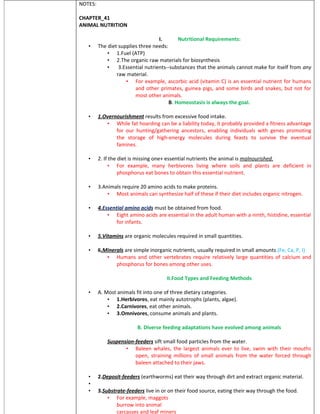
Chapter 41 Notes
- 1. NOTES: CHAPTER_41 ANIMAL NUTRITION I. Nutritional Requirements: • The diet supplies three needs: • 1.Fuel (ATP) • 2.The organic raw materials for biosynthesis • 3.Essential nutrients--substances that the animals cannot make for itself from any raw material. • For example, ascorbic acid (vitamin C) is an essential nutrient for humans and other primates, guinea pigs, and some birds and snakes, but not for most other animals. B. Homeostasis is always the goal. • 1.Overnourishment results from excessive food intake. • While fat hoarding can be a liability today, it probably provided a fitness advantage for our hunting/gathering ancestors, enabling individuals with genes promoting the storage of high-energy molecules during feasts to survive the eventual famines. • 2. If the diet is missing one+ essential nutrients the animal is malnourished. • For example, many herbivores living where soils and plants are deficient in phosphorus eat bones to obtain this essential nutrient. • 3.Animals require 20 amino acids to make proteins. • Most animals can synthesize half of these if their diet includes organic nitrogen. • 4.Essential amino acids must be obtained from food. • Eight amino acids are essential in the adult human with a ninth, histidine, essential for infants. • 5.Vitamins are organic molecules required in small quantities. • 6.Minerals are simple inorganic nutrients, usually required in small amounts.(Fe, Ca, P, I) • Humans and other vertebrates require relatively large quantities of calcium and phosphorus for bones among other uses. II.Food Types and Feeding Methods • A. Most animals fit into one of three dietary categories. • 1.Herbivores, eat mainly autotrophs (plants, algae). • 2.Carnivores, eat other animals. • 3.Omnivores, consume animals and plants. B. Diverse feeding adaptations have evolved among animals Suspension-feeders sift small food particles from the water. • Baleen whales, the largest animals ever to live, swim with their mouths open, straining millions of small animals from the water forced through baleen attached to their jaws. • 2.Deposit-feeders (earthworms) eat their way through dirt and extract organic material. • • 3.Substrate-feeders live in or on their food source, eating their way through the food. • For example, maggots burrow into animal carcasses and leaf miners
- 2. V. Structural adaptations of digestive systems are often associated with diet • A.Dentition (teeth) reflects diet. • Particularly in mammals, evolutionary adaptation of teeth for processing different kinds of food is one of the major reasons that mammals have been so successful. • B.Large, expandable stomachs are common in carnivores. • For example, a 200-kg African lion can consume 40 kg of meat in one meal. • C.The length of the vertebrate digestive system is also correlated with diet. • In general, herbivores and omnivores have longer alimentary canals relative to their body sizes than do carnivores, providing more time for digestion and more surface area for absorption of nutrients. • The most elaborate adaptations for a herbivorous diet have evolved in the ruminants, which include deer, cattle, and sheep.
